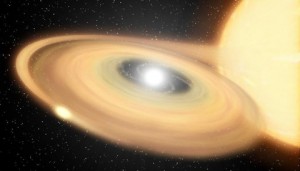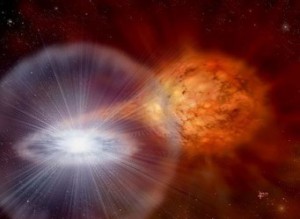Astronomers have detected gamma-ray emission from three classical novae, an unexpected discovery that has left them perplexed.
Some days, it seems like everything is dumped on you. As the pressure builds, you finally hit a point at which you just lose it and explode.

NASA / JPL-Caltech
White dwarfs can have the same problem. When one of these stellar corpses funnels gas off a companion star, the white dwarf builds up a layer of material on its own surface until the temperature and pressure are so high that they trigger a thermonuclear explosion. The bright outburst, called a nova, can blaze for months. And unlike their brighter cousins the supernovae, novae don’t destroy the star and can actually repeat.
Observations with NASA’s Fermi Gamma-ray Space Telescope now show that nova-ing white dwarfs throw a surprisingly energetic fit when they’ve had enough. Fermi observations of three “classical” novae — V959 Monocerotis 2012, V1324 Scorpii 2012, and V339 Delphini 2013 — reveal that these eruptions produce gamma rays, heretofore unexpected from this type of system.
Each of the three novae emitted gamma rays over 2 to 3 weeks, with the gamma-ray peak following the optical peak by a couple of days. (The Fermi-LAT collaboration can’t confirm the delay for V959 Mon, because the nova was too close to the Sun for optical observations when detected with Fermi in June 2012.)
The gamma-ray delay happens because the material the white dwarf ejects initially blocks the high-energy photons from escaping, and the gamma rays can only get out when the material expands and thins.
Amateur astronomers actually helped confirm that two of the three transient gamma-ray signals came from novae. Amateurs fought the dawn to pick up the optical glow from V959 Mon in August, confirming the gamma-ray outburst was from a nova. After that, cooperation with spectroscopy-savvy amateurs enabled the Fermi collaboration to plan their observations of V339 Del after an amateur discovered that nova as well. The third nova was found by a professional team.
Mysterious Gamma Rays

Credit: David A. Hardy http://www.astroart.org & Science and Technology Facilities Council
The first and only other nova detected in gamma rays is V407 Cygni, reported in 2010. That system’s white dwarf closely orbits a swollen red giant star, which spews out a thick wind. Astronomers think V407 Cyg created its gamma rays when the nova blast hit this wind material, creating a shock wave that accelerated the charged particles (electrons, protons) that then created the gamma rays.
But the three new novae are from systems that don’t have these hefty winds — there’s ostensibly nothing for the blast wave to crash into.
“It was thus a complete surprise to see gamma-rays from classical novae,” explains Brian Metzger (Columbia University), who works on high-energy and stellar astrophysics. Although radio and X-ray observations have long hinted that shocks exist, this is the first “irrefutable evidence” of particle acceleration at such shocks, he says.
Yet without a companion’s wind to crash into, the ejected material needs to be hitting something to create the shock. That suggests the outflow from the white dwarf’s surface might have first been slow and then fast, with the fast wave smacking into the slower-moving stuff. But current theory doesn’t explain why that change would happen, Metzger says.
Given the similarity of the gamma-ray signals from the three novae, the same process likely creates the emission for all three objects, says study coauthor Teddy Cheung (Naval Research Laboratory). “This is satisfying but puzzling at the same time,” he says, “because it implies there is some general mechanism operating in thermonuclear explosions that make high-energy gamma rays, despite differences in the systems” — differences such as the mass and composition of the white dwarfs and the binary system itself.
Cheung agrees that shocks are a plausible explanation, but any shocks involved in making gamma rays would need to be stronger and shorter lived than the ones that create radio and X-ray emission. They’d also likely be more localized, because the radio and X-ray emission tend to occur over larger volumes in the nova ejecta, he adds.
“The origin and location of the gamma ray emission is the key open question,” he sums up. The explosion definitely starts with the thermonuclear runaway on the white dwarf’s surface, he explains, but it’s still unclear where and when the gamma rays are produced.
Reference: Fermi-LAT Collaboration. "Fermi establishes classical novae as a distinct class of gamma-ray sources." Science. August 1, 2014.
Prepare for next year's astronomical fun with our 2015 wall calendar.
 0
0









Comments
You must be logged in to post a comment.